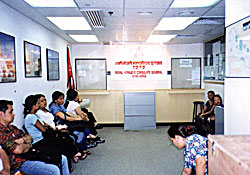 RAMYATA LIMBU |
Eleven per cent of the remittance money that comes into Nepal from abroad is the money sent by women migrant labourers. That data itself is eight years old. And, the 2001 Nepal Living Standard Survey and does not include money sent home from Nepali women working in India.
The 2001 census showed that more than 700,000 Nepalis worked in India. That figure is estimated to have at least doubled due to war, increase in population and fragile food security. We don't have more recent data on the total number of workers in India, so there won't be any new gender, age group, income level, types of profession or family size breakdowns.
Until 2007, when the new Foreign Employment Act was formulated it was illegal for Nepali women to seek work abroad. Women and children were lumped into the 'vulnerable groups' category and couldn't leave directly from Nepal if they found jobs abroad.
But, Nepali women have been leaving their home villages to escape poverty, domestic abuse, political and social violence for decades. This trend increased during the conflict years. Since they couldn't fly from their home country, they travelled to India and left for the Gulf. That is why there are no records of how many women get stuck in India, how many make it to Lebanon or Kuwait and how many are trafficked to brothels.
The only thing certain about the figures is that they are uncertain. Of the 15,000 Nepali labourers in Lebanon, 80 per cent are women. There are now over 70,000 Nepali women working as domestics in Saudi Arabia. All guesstimates.
Since 2007, Nepali women can legally seek employment in most countries. The government will also have a women labour attach? in the host countries where Nepali women work: There's a labour desk at the international airport in Kathmandu. And if workers want to fly via India, they will need to present a letter from Nepali embassy in Delhi with details at the Indian immigration before they depart.
Good rules designed to check exploitation. But hardly ever implemented. Despite being legally allowed to go abroad to work, government rules make it as difficult as possible for them to do so.
This has again forced them to go through agents in India, exposing them to exploitation and adding to the cost.
"When I went to Kuwait the first time, I didn't follow my country's regulations," said one Nepali female returnee from Kuwait, "they say that it is now legal to go but those policies are in paper only. I have been running between ministries, agencies and organisations for five months, spent so much money, and I still haven't been allowed to leave." She says she may have no option but to fly out via India again.
In terms of migration in India, there's a debate on whether or not female sex workers in India can be considered migrant labourers. There are those who say that because Nepali sex workers have been trafficked and are forced and exploited, they need to rescued and protected. But because they add to the labour pool and are sending remittance home, they cannot be discounted.
One of the reasons why sex workers haven't been included in studies and official figures is because we simply don't know how many Nepali women are in the Indian sex industry. Researchers who have been studying migration say that the purchasing power of people in rural Nepal has increased, and significant portion of it is also because of the money sent home by sex workers in India. But no one has ever tracked how much money that is.
The 2007 policy made a gross mistake in not including migration to India under the category of foreign employment. The government's logic was that if you don't need a passport and a visa, you haven't really left. But there are hundreds of thousands of Nepali men and women working in India who send millions of rupees home and contribute to the economy. Their rights are not protected, there is no one to speak for them if they are exploited, abused or killed. They have been forgotten by Nepali law and have become invisible citizens.



